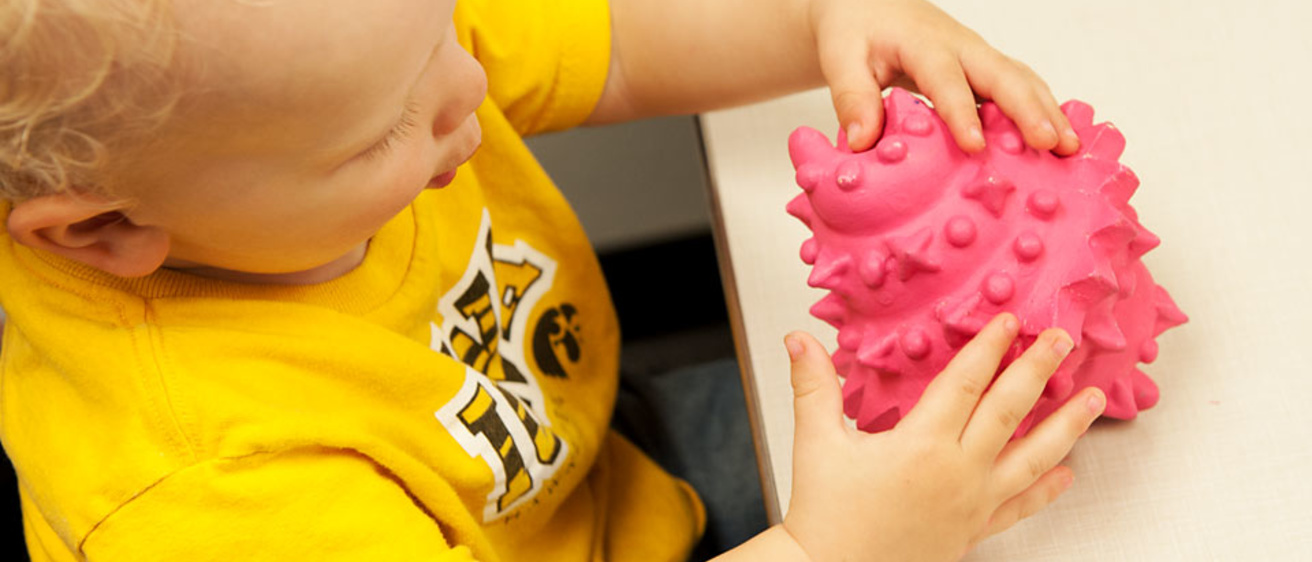Two mothers are teaching their toddlers new words using novel objects. The mothers use the same words and the same objects in the same situation. One child learns the words better and more consistently than the other.
What’s the difference?
Well, it may have to do with something as simple as the space things occupy.
A recent University of Iowa study has shown that parents and caregivers who keep novel objects spatially separated and in consistent spaces while teaching words have children who learn the names of those objects better.
“Research suggests that our memory system uses space to keep track of things.”
—Larissa Samuelson, associate professor of psychology
Led by Larissa Samuelson, associate professor of psychology in the UI College of Liberal Arts and Sciences, the researchers expanded upon a classic task done by psychologist Dare Baldwin. In Baldwin’s study, 18-month-old children were introduced to two novel objects they had never seen before. The children familiarized themselves with the objects and then, out of the sight of the children, the objects were put into two identical buckets. The buckets were then placed in front of the children, the researcher looked into one of the buckets, said a word, and then removed the object from the other bucket that she hadn’t been looking into and gave it to the child. Both objects were then taken out of the buckets, and the children were asked to find the named object. The children were able to do so, even though they could not see the object when it was originally named.
Samuelson and her team wanted to know how such young children could keep track of what was in each bucket and what was being labeled, and thought spatial consistency might be the answer.
“We don’t always think about it, but anytime you’re interacting with someone, one of the most constant things in our environment is the space around us,” Samuelson says. “Space is very interesting because two objects can’t occupy the same space at the same time, so it actually provides a very interesting way to separate objects. Research suggests that our memory system uses space to keep track of things.”
Samuelson conducted the study with John Spencer, UI professor of psychology; Lynn Perry, a UI doctoral student in psychology; and Linda Smith, a professor of psychology at Indiana University. The research involved 130 children between 17 months old and 22 months old in a series of six different studies. The first study duplicated Baldwin’s original study, but “messed up the space,” Samuelson says. Children were familiarized with one object on their left and one on their right. Then the objects were switched—the right object was moved to the left and the left object to the right.
“We found that those children were ‘at chance’ for recognizing the objects,” Samuelson says. “During the comprehension tests, they were not able to get to the object that we had intended. That suggests that messing up space makes it harder.”
Other studies suggested that the presence of the object wasn’t required for children to make the spatial connection. Pointing to a location in space and saying the name of the object or snapping in a location and saying the name of the object helped children make the name-object connection as well.
“The idea is that when I point to that space and label it, it cues their memory for what was in the space. Having that memory active at the time that word is heard is what helps them to get the right two things together,” Samuelson says.
The last study looked at parents—mostly mothers—and their young children. The mothers were given some novel objects and were told to teach their children the names of the objects. After the parents had time to play with the children and teach them the names of the objects, the children were tested on how well they had learned the words. The mothers were not instructed to keep the objects in the same space, but a portion of them did. Between 50 and 80 percent of the time, the mothers kept the objects in a consistent spatial location. Those mothers who kept the spatial location consistent more often had children who learned the words better.
Samuelson suggests to parents that one simple daily application of spatial consistency is keeping things organized in the home. Keeping diapers consistently near the changing table or knowing that spoons and other utensils are always in the same space in the kitchen can help children learn those words faster.
“You don’t have to go out and buy a lot of fancy toys to do something like this,” Samuelson says. “I think sometimes parents, especially in this material culture, with ads for Baby Einstein and all these things, feel like that’s the way you have to do it, but it’s not. Go to the window with your child, point to the cars going by and the birds in the trees, make the noises. Play games where you keep things in spatial locations and let them work on it. It’s that simple.”
